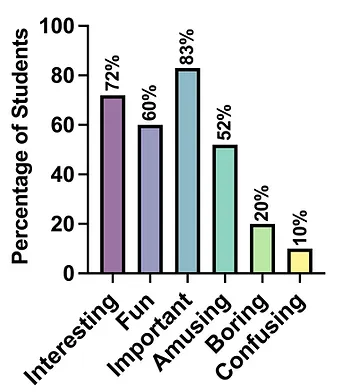The Adventures of Science Communication: Using comics to engage young audiences
By Caroline Cencer
Title: Developing Pandemic Comics for Youth Audiences
Author(s) and Year: Judy Diamond, Amy Spiegel, Trish Wonch Hill, Elizabeth VanWormer, Judi gaiashkibos, Bob Hall, Aaron Sutherlen, and Julia McQuillan, 2021
Journal: Journal of STEM Outreach
TL;DR: Comic books are a tool for sparking scientific interest in youth. A team of educators, artists, and scientists developed a COVID-19 comic book series, C’RONA Comix, for young readers with three major themes (1) the biology of the virus, (2) the relationship of wild animals (bats) to the pandemic, and (3) the impact of the pandemic on Tribal communities.
Why I chose this paper: As a scientist, I am interested in unique ways to present science research and data to the public. I believe that art can function as a universal language, to transmit important research conclusions to multiple audiences in a less intimidating manner. This paper presents how scientific comic books can be used to educate young audiences about emerging science topics.
Introduction
In the past three years, the media has been continuously saturated with news of the COVID-19 pandemic and vaccine development updates. When it comes to helping young people understand the pandemic, however, typical news stories fall short. How can they comprehend a threat that they cannot see? To encourage children to follow safety guidelines and be prepared for future public health events, they first need to comprehend the underlying reasons for social distancing and vaccinations. This presents educators and communicators with the challenge to create materials that appropriately communicate the science of viruses to students, while maintaining scientific accuracy.
The Comic’s Approach
When struck with the severity of the pandemic, and an immediate need to provide education materials for young audiences, a team of educators and scientists at the University of Nebraska Lincoln was awarded a Rapid Response Research program grant from the National Science Foundation. The one-year grant had the following three objectives: “1) leverage learning research approaches to better understand current youth conceptual understandings during a pandemic and how, during a crisis, science comic narratives impact youth understanding of and curiosity about science; 2) develop comic stories that will interest and engage diverse youth in grades six through eight to learn more about the basic biology of COVID-19; and 3) mobilize our partnerships with a publisher, schools, libraries, and museums to give youth direct access to the comic stories in print and digital forms.”
Since 2007, the group has created a number of science communication resources from radio shows and apps to popular children’s books. Advised by youth librarians that had seen a recent surge in popularity of comic books with preteens and teens, the group was then inspired to try comics as a science communication medium.
In a recent study published in the Journal of STEM Outreach, the Nebraska group partnered with a Marvel and DC comic artist to develop a comic book series, C’RONA Comix, to help middle and high school students understand the COVID-19 pandemic. Relatable “teen-like” characters of the C’RONA Comix series shrink down into a transporter pod, following the course of SARS-CoV-2 infection and how the immune system fights back (Figure 1). The series also covers difficult topics about quarantine and hospitalization. Two spin off series, Tribal C’RONA Comix and C’RONA Comix II, explored the particularly destructive effect of the pandemic on Native communities and the wildlife-seated origins of COVID-19, respectively.

Study Methods
Reaching out to a Nebraska high school, the group asked students enrolled in introductory biology classes to read the comics and complete a survey, getting feedback from 91 total students aged 14 to 17. Although the comic authors had a target age group of middle school students, they still felt that the high school students could provide insight into what may be appealing to younger ages. A newer study, currently underway, is focused on surveying a large population of 9,400 local middle school students.
Results
The comics evoked both positive and negative responses from high school students, which are covered in this study and broadly summarized in Figure 2. One student proclaimed, “I would describe it as interesting and it got me hooked on it and it showed a really good way on how the virus would spread and be exterminated.” The majority reacted positively to the comics and felt that the included health and science information was mostly accurate (57-79%). A small fraction, however, questioned the accuracy of the comics (7-16%). Additionally, some students included in this study did not enjoy comics as a medium for learning about science and rather, found them confusing (see Figure 2). Lastly, a large proportion of the students said that they would recommend the comics to a friend (89%) and even more so to someone younger than a high schooler (92%).

The Takeaway
Overall, comics appeal to young audiences and may serve as a new form of science communication. However, there are important aspects to keep in mind when using comics as a method of teaching science. While most comics we are familiar with tell fictional stories, science comics, according to the study authors, must create stories around facts, data, and real-life accounts. Additionally, it is important to illustrate a variety of character identities within the comics. Prior work from the authors has found that featuring characters from underrepresented groups in science can engage a wider student audience and encourage youth who may self-select out of science due to a lack of identity role models. Based on receiving some negative feedback from the high school students to C’RONA Comix, the authors stress that comics are not a replacement for current science communication methods, but rather an additional approach to engage younger audiences. In conclusion, the authors have shown the success of a new communication method, adding to the existing variety of formats to help reach a more diverse population.
Edited by: Andrea Isabel López and Niveen AbiGhannam
Cover image credit: Photo by Mikhail Nilov via Pexels

